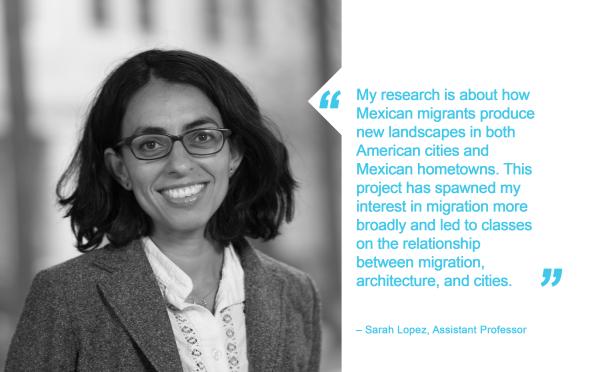Sarah Lopez, Faculty

In this post, we hear from Sarah Lopez. Dr. Lopez is a built environment historian, as well as a migration scholar. Broadly speaking, she teaches about U.S. cultural landscapes, the interface between migration, architecture, and cities, the use of interdisciplinary methods to study space and society, and world architectural history.
What program(s) are you associated with in the School of Architecture? How long have you been at the university?
I have been at the school for three years and work with the Architectural History, Community and Regional Planning, and Historic Preservation programs.
In what ways have you incorporated diversity and equity in your teaching and research?
My research is about how Mexican migrants produce new landscapes in both American cities and Mexican hometowns. This research project has spawned my interest in migration more broadly and led to classes on the relationship between migration, architecture, and cities.
Bringing migration theories and histories into the realm of architecture and planning equips spatial practitioners with tools for thinking through how contemporary movement interfaces with the production of space, and how unequal power relations produce asymmetrical landscapes. The class addresses and contextualizes the ‘immigrant neighborhood’, ‘ghetto’, and ‘enclave’.
I have also taught a course on the history, siting, design, and use of migrant detention centers in Texas. During this course, students engaged with various actors that produce these places, manage them, and organize on issues related to immigrant rights, as well as migrant asylum seekers who have been detained. This was a collaborative project spearheaded by the Humanities Action Lab (HAL) at the New School. 19 other universities also taught courses addressing the local incarceration and detention of individuals in their respective states. All 20 projects will be in a rotating exhibit with the intention of fomenting public dialogue about the various injustices and paradoxes of mass incarceration today.
Finally, my course on U.S. cultural landscapes—organized around the form, style, and context of buildings types and landscape elements such as bungalows, shopping malls, libraries, courthouses, plazas, apartments, the grid—allows students to examine 19th and 20th century U.S. built environment history. We examine the American landscape as a composite of discrete building types and landscape elements that embody social, political, and cultural processes. Such examination allows us to explore the histories, identities, and cultural transformations of individuals who are often not included in canonical histories.
What does diversity mean to you?
A diverse orientation or perspective means being actively interested in difference, and then pursuing that interest in the real world (i.e. how difference plays out, what life is like for a broad spectrum of individuals and communities in our cities and world).
Can you describe the sense of community at the School?
The student body at UTSOA is eager and ready to engage prescient social and environmental issues in the real world. And, there is a demand and desire to draw connections between the world of architecture, preservation, planning, and those issues. Students and faculty are searching for innovative ways to engage issues and problems that they might not directly experience and developing a new curriculum that provides students with opportunities to learn from Austin’s rapid demographic and social change. This common project and purpose creates dynamic engagements and exchanges.
What are your aspirations –big or small– for the future?
To continue teaching about how migrants shape American cities, but to expand how emigrant homelands (and specifically the built environment of those homelands) shape the migration process, as well as the architecture and development of American cities. I also hope to expand my work on U.S. cultural landscapes to include Mexican cultural landscapes, demonstrating how the two are intertwined and interdependent.

